of the Muncie Public Library, Mary Lou Gentis & the Staff of the
Local History and Genealogy Dept.
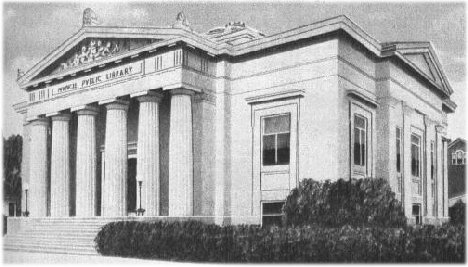

It was 1903. A unique and wonderful building was
being erected in Muncie, Indiana: the
Muncie Public Library. Frank Garrett, listed in
the 1903-04 Muncie City Directory as a
decorator, was one of the many men who applied
their fine crafts to this important project.
He was listed as boarding at 210 E. North Street.
Prior to that, 1889 & 1890, Frank was
shown living in Indianapolis.
Frank P. Garrett wanted to be remembered. A laborer
by trade, he was probably not a
wealthy man. Perhaps he traveled to where the work
was, from town to town. No one
knows for sure but it appears he decided to stay in Muncie.
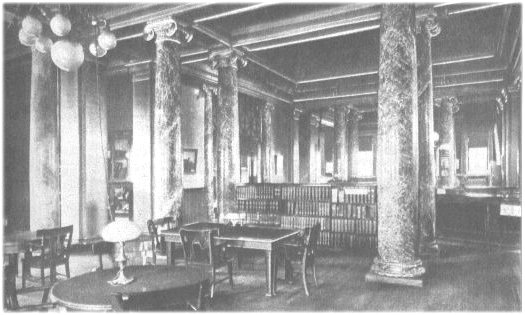
Fast forward 100 years to 2003. Muncie has begun
a project to refurbish and enlarge the old
library. The project begins by gutting many of
the wonderful features of the old bldg, mainly
to make her safe again. A large new section behind
the original structure will be devoted to
genealogy.

Photo courtesy of Muncie Public Library
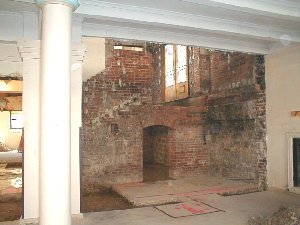
Photo courtesy of Muncie Public Library
Two members of the staff walk through the old building
surveying the surroundings to which they've grown accustomed. The mantle
on one of the old gas fireplaces catches their eye. They move closer and
touch it. It's loose. Something behind the mantel looks odd and out of
place.
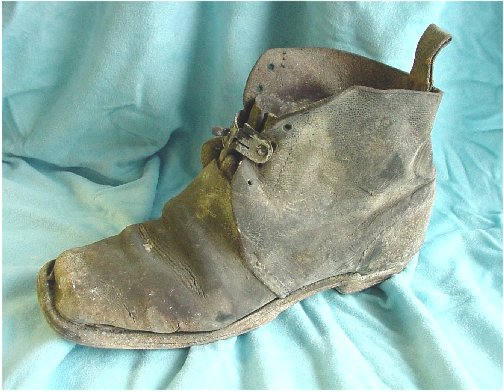
Photo by Shirley Baston Pearson
There, placed strategically on a board, was a
shoe.
A small piece of paper with Frank's name and address was
stuffed inside the shoe. (The library staff member who found and read this
paper let it slip from her hand. The paper fell to the ground and was blown
away by a gust of wind - lost forever.)
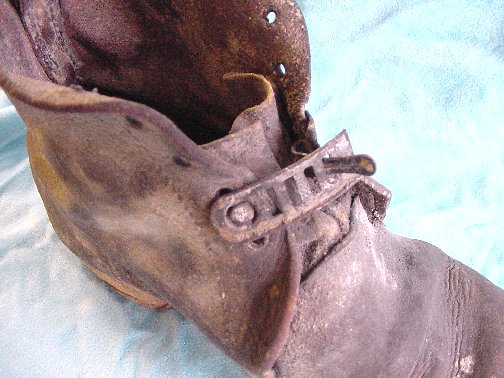
Photo by Shirley Baston Pearson
Back to 1903. It was time to throw out the old shoes
anyway. They'd been repaired many
times and were beyond saving. Frank had finally replaced
them with new shoes and was
ready to part with the old ones. Then he got an idea.
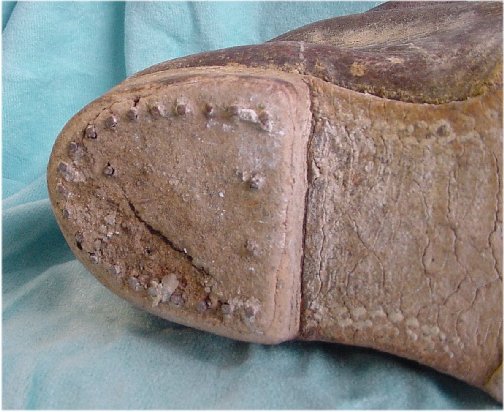
Photo by Shirley Baston Pearson
Perhaps Frank carried one old shoe to work that day under his arm, or in a paper bag. Perhaps he placed the old shoe in the wall in secret or maybe some of his co-workers watched and laughed. No one will ever know for sure but Frank did make sure we would someday know he had worked on this building. Frank placed a note with his name and address inside his shoe. He had no way of knowing when that building would come down, if ever, or if that shoe of his would be found. Wouldn't it be nice if Frank were watching now?
Frank's shoe is currently being cherished by the staff of the Local History and Genealogy Department of the Muncie Public Library. Mary Lou Gentis, head of that department, is digging deep into archives, old library records, and public records to enlighten us about Frank P. Garret. I don't mind telling you it's been fun watching the staff and patrons speculate about Frank and how his shoe got into the wall behind the mantle. Did Frank go home with one shoe missing that night? How did he explain his missing shoe to Mrs. Garret? Did he plan this ahead of time or was it a spontaneous act? Is there another shoe hidden someplace? Do all building trades people do these sort of things or is it just our dear Frank being ornery? But the one burning question is: Does Frank know we found his shoe? If so, he must be having a good laugh.
Frank must not have been a big man. His shoe is about a man's
size 8 or, for comparison, a woman's size 9. Some of the repairs
on his shoe could have been done by a cobbler but some look like they were
done by Frank himself.
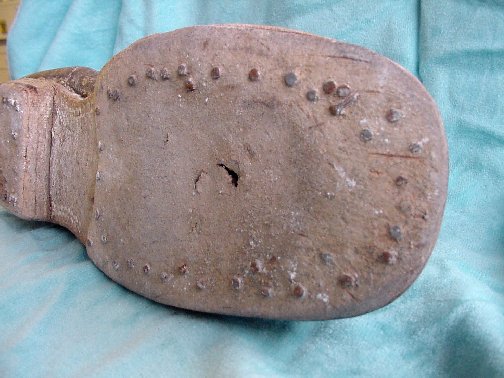
Photo by Shirley Baston Pearson
Mary Lou found Frank's obituary, which tells us a little
more about Frank. In the meantime,
I'm trying to locate some family who can claim Frank.
We think it might be fun for them to
see his shoe. Mary Lou will continue to dig for more
details and keep us posted.
If you can furnish any information on Frank, please contact
me at:
Shirley
Pearson
******
Muncie Star, January 7, 1906
FRANK P. GARRETT IS DEAD
Demise of Well Known Contractor and Member of Elks
After an illness extending over a period of six weeks,
Frank P. Garrett, 56, a well known
contractor and a prominent member of Muncie lodge of
the Elks, died last night at 10:15
o'clock at the home of Mrs. Lena Richey, 2? east Gilbert
street. The death of Mr. Garrett had
been expected for the past few days, as it was known
that he was dangerously suffering with
Bright's Disease. Mr. Garrett was one of the oldest
members of Muncie lodge of Elks, and
was highly respected by all who knew him.
Following death, the remains of the deceased were taken
to the Meeks morgue, where they
will be prepared for burial. The funeral which will be
in charge of the Muncie Elks, will be
announced later. The body will be taken to Hamilton,
O. for burial
******
Meeks Mortuary records show that responsibility for
Frank's remains were taken care of by B.P.O.E.
**********
Shoe in the Wall is Ancient Superstition
Thanks to Virginia, one of the Delaware County list subscribers
and volunteers, we've
learned that putting a shoe in the wall of a home is
an ancient superstition and was practiced
as late as the 1930's in different parts of Europe and
the United States.
No one knows how far back this practice goes but some
think it dates to prehistoric times
when a person was killed and buried in the foundation
of the structure. Supposedly this
would help hold the house together. As time went
on, a shoe became the replacement for
the sacrifice, perhaps because the shoe held the imprint
of the wearer and, therefore, might
hold the spirit. This spirit was supposed to have
protected the home.
Older homes with newer additions have been known to reveal
more than one "shoe in the
wall", perhaps one for each new addition. Most
shoes have been those of children or women
and sometimes are placed with other items such as toys
or utensils. Most placements were
at points considered to be weak or vulnerable to evil,
such as near windows, doors or
chimneys.
It's my understanding that the shoe, when found, should
not be removed. Most are removed
simply because those finding the shoes are unaware of
the significance of their discovery.
The writer of this piece now has three new burning questions:
1) Why did the note get blown away?
2) Should the shoe be put back into the wall??
3) Should yet another shoe be put into a wall???